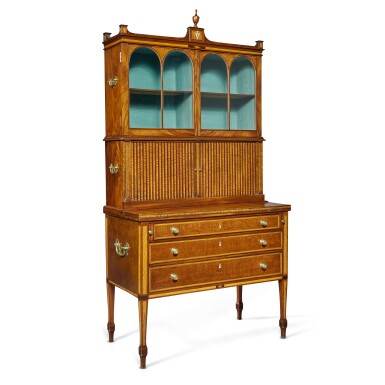Auctions
Buy Now
Collectibles & More
Books & Manuscripts
Important Americana: Furniture, Folk Art, Silver, Chinese Export Art and Prints
Important Americana: Furniture, Folk Art, Silver, Chinese Export Art and Prints

Property from a Westchester, New York Collection
Auction Closed
January 20, 04:11 PM GMT
Estimate
80,000 - 120,000 USD
Lot Details
Description
Inlaid mahogany, satinwood, brass.
Height 84 1/2 in. by Width 37 1/2 in. by Depth 19 3/8 in.
Finial replaced
William Richmond, Greenwich, Connecticut;
Col. Edgar and Bernice Chrysler Garbisch, Pokety Farm, Cambridge, Maryland;
Sotheby Parke Bernet Inc., New York, The Garbisch Collection: Volume Four, Important American Furniture and Related Decorative Arts, May 23-25, 1980, sale H-2, lot 1157;
Bernard & S. Dean Levy, Inc., New York.
This tambour desk and bookcase shares a sophisticated design and quality of workmanship associated with furniture made by John (1738-1818) and Thomas Seymour (1771-1849) of Boston. It was formerly in the famous collection of Colonel Edgar and Bernice Chrysler Garbisch at Pokety Farm in Cambridge, Maryland. It survives in very fine condition, retaining its original glass panes, robin’s egg blue paint and working key for the top escutcheon.
Made around 1800, this desk is an early example of a form made by the Seymours to which they added a top bookcase section to their tambour secretary form. The top of the tambour section is finished mahogany indicating that the desk was designed to be used with or without the removable bookcase top. It displays carefully conceived veneering that is executed in an artistic manner to create visual interest on the form. It is enhanced with other design features characteristic of the Seymour shop such as the use of alternating reeds for the tambour doors; curly satinwood on the plain rectangular cornice; patterned stringing including two different patterns for the top board and writing flap; inlaid pilasters flanking the tambour doors; robin’s egg blue paint; Ivory key escutcheons (here replaced with ivorine) including a top one in the form of a neoclassical vase; and tapering rectangular legs inlaid with veneered panels and with squared ankles.
A closely related desk and bookcase attributed to John and Thomas Seymour is in the collection of the Museum of Fine Arts, Boston.1 Both desks share the same overall design and display bookcase doors with rounded arches rather than the pointed Gothic arches more commonly found in other Seymour work. That desk also has a finished mahogany top of its middle case and retains remnants of its original blue paint. Similar ivory neoclassical vase escutcheons are found a sideboard at the Metropolitan Museum of Art which is attributed to Thomas Seymour and possibly made with John Seymour with carving attributed to Thomas Wightman.2 The sideboard also retains its original blue paint behind the tambour doors. For another desk and bookcase of this type attributed to the Seymours with a finished mahogany top on the tambour section, see one with a history in the Procter family currently in the collection of the White House Historical Association.3
1 Museum of Fine Arts, Boston, acc. no. 1939.625. See Robert D. Mussey Jr., The Furniture Masterworks of John & Thomas Seymour (Salem: Peabody Essex Museum, 2003): no. 19, pp. 172-173.
2 Metropolitan Museum of Art, acc. no. 65.188.1. See Mussey, no. 43, pp. 220-221.
3 White House Historical Association, acc. no. 974.1073.1. See Mussey, no. 20, pp. 174-175.